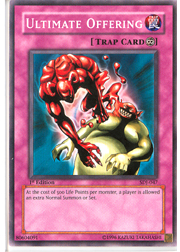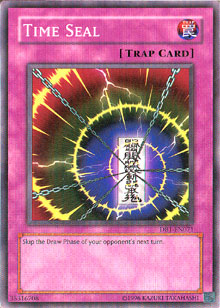Before I get started today, I’d like to give a big “thank you” to everybody who’s emailed me in the past month about the Dark World Fiends. You guys helped inspire me to write so much on that popular sub-theme of Elemental Energy, and I really appreciated all of your feedback over the course of the two articles. You all rock!
Since this game’s release, there have been many great cards (along with many a good card) that have debuted here on American shores. Of course, just because a card is great doesn’t mean that duelists catch on to its power immediately. This can be said about many of the gems that were released in Ancient Sanctuary—a set that was highly overlooked by most players, simply because its rare cards were generally lacking in competitive tournaments. However, some of the best cards ever to be released, including Enemy Controller and Night Assailant, could be found in this set.
Today’s card of choice has been overlooked since its release back in April of 2002. Ultimate Offering made its debut in the very first Yu-Gi-Oh! starter decks, and it’s seen relatively little play throughout its history. This is unfortunate, because Ultimate Offering is also one of the most powerful continuous traps to date.
The Basic Breakdown
 The text on your Ultimate Offering may be ambiguous, as the card was released over three years ago when effects weren’t written nearly as clearly as they are now. The following is the correct text, courtesy of the official Yu-Gi-Oh! Trading Card Game website’s card errata section.
The text on your Ultimate Offering may be ambiguous, as the card was released over three years ago when effects weren’t written nearly as clearly as they are now. The following is the correct text, courtesy of the official Yu-Gi-Oh! Trading Card Game website’s card errata section.
By paying 500 Life Points, Normal Summon or Set 1 extra monster. You can only activate this effect during your Main Phase or your opponent's Battle Phase.
You may notice that this card acts very similar to a special summon. However, unlike a special summon, Ultimate Offering can trigger effects that may activate only upon a normal summon or tribute summon. Of course, this effect also doesn’t allow you to get around summoning high-level monsters without tributes; namely, if you want to summon a monster such as Dark Magician of Chaos through a normal summon or set.*
With that clarified, I’m about to make a statement that I’m sure will cause me to be laughed at during the next Southern California regional event by members of Comic Odyssey, and possibly Team Savage. “Ultimate Offering is a ridiculously busted card.”
If you read that statement and you got a bit of a headache, be sure to read it again, because I stand by it. Of course, let me explain my reasons. If you were to talk to competitive gamers who play other card games, they would tell you that some of the best cards are the ones that break the rules of the game. For example, in Yu-Gi-Oh!, monsters that are destroyed should go to the graveyard. Special summoning monsters from the graveyard could be considered a method of “breaking the rules,” as it goes against the fact that monsters usually stay dead when they die. Likewise, Return from the Different Dimension is a ridiculous card, because it takes an area of the game that’s generally unaffected by game mechanics and places it into the monster zone.
In the Yu-Gi-Oh! rulebook, you will note that you’re allowed as many special summons as you can perform during a turn, but you’re allowed only one normal summon or set each turn. Hence, Ultimate Offering breaks this rule by allowing you to normal summon as many monsters as you can during a turn, providing you have the life points to pay for its cost. You can almost think of using Ultimate Offering as making a deal with the devil. You’re paying your own life in order to bend the rules in your favor with this continuous trap card, similar to how you might sell your soul to save someone’s life . . . or to get x-ray vision!
However, Ultimate Offering doesn’t simply break the rule of having one normal summon per turn. This continuous trap card also allows you to normal summon or set monsters during your opponent’s battle phase. This effect is so ridiculous that it allows for some of the safest and most powerful summons and sets you can make! Perhaps you fear that your opponent might have Don Zaloog ready to swing at your life points. You can pay 500 life points to set a monster when it attempts to attack you directly. You’ll lose no advantage, and you won’t take the full 1400 damage. If you expect that your opponent may have Smashing Ground ready to break away any monster you summon, you can wait until your opponent’s battle phase to summon that monster instead. This gives you protection through your opponent’s next turn, as the only way that he or she could play a threatening spell card like Smashing Ground at that point would be to enter main phase two. It’s pretty obvious that Ultimate Offering has a lot of unexplored power.
Combos and Strategies
 I don’t think any other cards fully exploit the aspect of being tribute summoned more than the Monarchs. Mobius the Frost Monarch, Thestalos the Firestorm Monarch, Zaborg the Thunder Monarch, and Granmarg the Rock Monarch all have fantastic effects. Now imagine if you could trigger those effects during a main phase when you have a clear field. Better yet, imagine tribute summoning these behemoths during your opponent’s battle phase, which will trigger the Monarch’s abilities during the opponent’s turn! Effects like these that happen during your opponent’s turn can be the ultimate method of disruption.
I don’t think any other cards fully exploit the aspect of being tribute summoned more than the Monarchs. Mobius the Frost Monarch, Thestalos the Firestorm Monarch, Zaborg the Thunder Monarch, and Granmarg the Rock Monarch all have fantastic effects. Now imagine if you could trigger those effects during a main phase when you have a clear field. Better yet, imagine tribute summoning these behemoths during your opponent’s battle phase, which will trigger the Monarch’s abilities during the opponent’s turn! Effects like these that happen during your opponent’s turn can be the ultimate method of disruption.
The “empty hat” monsters that are special summoned by Magical Hats don’t have a long life span, but nothing on the effect of this deck-inspiring trap card says that those Hats cannot be tribute summoned. This means that if you have Ultimate Offering active, you are free to use those spell and trap cards that are posing as monsters to fuel the tribute summons of your more powerful monsters.
One of my personal favorites, and probably one of the more devastating combinations with Ultimate Offering, is Penguin Soldier. Once I discovered that Tsukuyomi was going to be limited (which was a dark day in my Yu-Gi-Oh! world), I was frantically looking for some sort of monster that could effectively replace my favorite card. This monster took the form . . . of a penguin. Penguin Soldier’s ability is not limited to targeting monsters on the opponent’s field, as you have the option to return itself as well as a used flip effect monster to your hand. More importantly, this cute little monster fills the hole in the Tsukuyomi lock, when combined with Ultimate Offering. The goal is to flip summon Mask of Darkness to return a freshly activated Time Seal to your hand when your opponent has burned out his or her resources. Your next step is to set Time Seal and to flip summon Penguin Soldier, returning both the Mask and the Penguin to your hand. Next, you pay 500 life points to set your Penguin Soldier, and then use your normal set to place Mask of Darkness face-down into your monster zone.
 Since your opponent has burned out his or her resources (which is a very easy position for someone to achieve in this format), he or she cannot do anything, due to Time Seal. During your turn, you activate Time Seal and then go through the previously mentioned actions to repeat this process. However, there is a limit to how often you can perform this “soft lock,” as you are spending 500 life points per turn. Of course, if you’re drawing cards every turn while your opponent is simply passing the turn with no actions at all, it’s safe to say that you’re probably going to win the duel by drawing into an authentic win condition, such as a Monarch.
Since your opponent has burned out his or her resources (which is a very easy position for someone to achieve in this format), he or she cannot do anything, due to Time Seal. During your turn, you activate Time Seal and then go through the previously mentioned actions to repeat this process. However, there is a limit to how often you can perform this “soft lock,” as you are spending 500 life points per turn. Of course, if you’re drawing cards every turn while your opponent is simply passing the turn with no actions at all, it’s safe to say that you’re probably going to win the duel by drawing into an authentic win condition, such as a Monarch.
Final Thoughts
Ultimate Offering has been a card that I’ve loved to play around with in testing over the past few months. It’s included in quite a few rough decks of mine that I never fully constructed, and it’s a shame that I haven’t had more time to play around with this continuous trap card. It’s one of the best traps to ever be released in this game, as the concept of effectively breaking the rules of the game is more than enjoyable. It’s also an effective strategy to follow when building new and effective deck types.
Next week will be my last article for the year, and I have a real treat in store for all of you. I hope you’ll like it. On that note, if you have any questions or comments regarding this or any previous articles, feel free to email me at Mrosenberg at Metagame dot Com.
*Although I can never imagine anyone on this planet actually setting Dark Magician of Chaos.